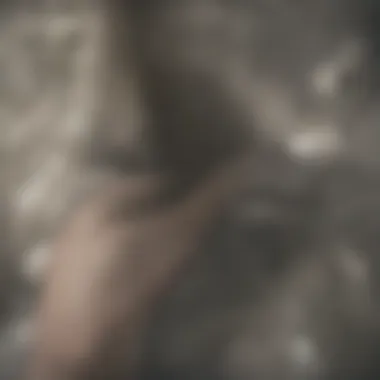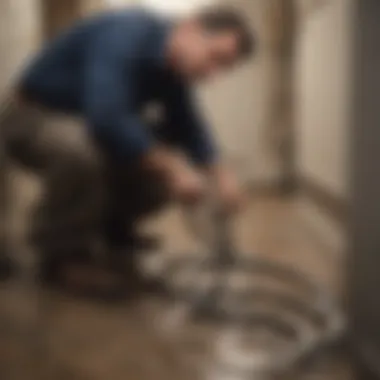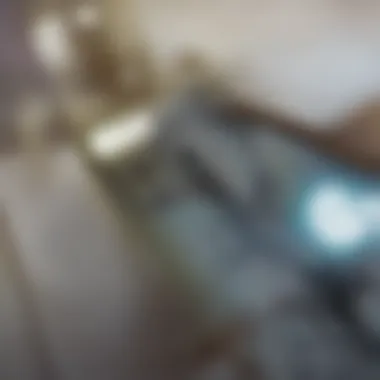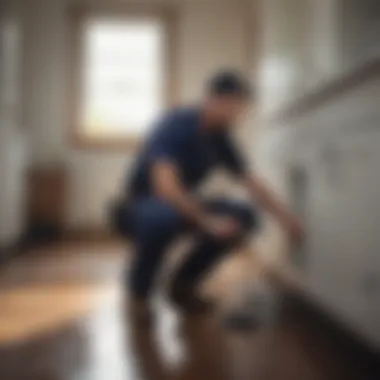The Importance of Drain Snaking for Homeowners


Intro
The plumbing system in any home is often taken for granted, yet its proper function is vital to the comfort and health of its inhabitants. Among the array of plumbing services available, drain snaking holds particular significance. It addresses what is often a simple, yet frequently overlooked issue: drain blockages. Blocked drains are a common nuisance, and they can escalate into serious problems if not managed promptly. This overview aims to elucidate the necessity of drain snaking, the processes involved, and the maintenance practices that can help prevent the issue altogether.
Understanding the causes of drain blockage is crucial. These can range from organic material like hair and food debris to more severe blockages caused by tree roots infiltrating sewer lines. Ignoring these problems can lead to costly repairs and extensive damage. It is here that the practice of drain snaking becomes relevant, as it serves as a preventive measure and a remedy for these issues.
In this article, we will delve into the tools and techniques used in drain snaking, highlight when it is time to seek professional help, and discuss the benefits of routine maintenance to sustain plumbing health. We will also provide insights into selecting a trustworthy plumbing service, ensuring that readers are equipped with the knowledge needed for efficient home maintenance.
Through this exploration, readers will gain a comprehensive understanding of the critical role drain snaking plays in household plumbing, enabling them to make informed decisions for their properties.
Understanding Drain Blockages
Understanding drain blockages is pivotal for maintaining plumbing health. Blocked drains can lead to more severe plumbing issues if left ignored. Identifying blockages early can save homeowners both time and money. The following sections outline the common causes and signs of clogs.
Common Causes of Clogs
Hair Accumulation
Hair accumulation is a frequent contributor to drain blockages. It tends to gather in pipes over time, forming clumps that impede water flow. This aspect of drainage maintenance is vital because hair is often found in bathrooms and sinks. While it may seem trivial, addressing hair accumulation is essential. The unique feature of hair is its ability to entangle with soap scum and other debris, forming difficult-to-remove masses. This can lead to more serious issues in the plumbing system if not addressed promptly.
Grease Buildup
Grease buildup is another common cause. It occurs in kitchens where food preparation and cooking take place. Over time, grease cools and hardens inside pipes, narrowing passageways. Grease accumulation is significant because it often goes unnoticed until it leads to substantial clogs. The characteristic of grease buildup is its gradual nature, making it a hidden threat. Once it forms, it can be challenging to eliminate without professional tools.
Foreign Objects
Foreign objects in drains can cause immediate blockages. Items such as toys, toiletries, or even construction debris can obstruct water flow. This immediate impact is why understanding foreign object intrusion is vital. The clear characteristic of foreign objects is their unpredictability; they often enter drains accidentally. Their unique feature is the potential to cause sudden and severe clogs, requiring prompt removal.
Tree Root Intrusions
Tree root intrusions are a less common but significant cause of drain blockages. Roots seek moisture, often finding their way into sewer lines. This infiltration can cause extensive damage and persistent blockages. The key aspect of tree root intrusions is their potential for long-term impact, as they can lead to costly repairs. The unique feature of this issue is the biological aspect, where living trees signal the necessity for preventive measures in landscaping.
Signs of a Blocked Drain
Slow Drainage
Slow drainage is typically the first sign of a blockage. Water taking longer to empty can indicate an obstruction in the pipes. Recognizing slow drainage early can mitigate further plumbing problems. A critical feature of this sign is its clarity; homeowners can notice it easily in everyday activities. Understanding slow drainage helps homeowners take timely action before conditions worsen.
Unpleasant Odors
Unpleasant odors often accompany blocked drains. These scents result from stagnant water and decaying debris within pipes. Recognizing these odors is vital for effective intervention. The key characteristic of unpleasant odors is their noticeable impact on the home environment. They can signal serious issues that require prompt attention before they escalate.
Water Backflow
Water backflow happens when wastewater flows back into sinks or tubs. This is a serious warning sign of significant blockages. It highlights the need for immediate action to avoid property damage. The distinct characteristic of water backflow is its ability to create unhygienic conditions. Understanding this sign can prevent health risks associated with contaminated water.
Gurgling Noises
Gurgling noises can be heard indicating a plumbing issue. These sounds result when air struggles to pass through water-obstructed passages. Their presence highlights the need for inspection. Gurgling noises are a subtle, yet crucial, indicator of trouble in the plumbing system. Recognizing these noises may assist homeowners in addressing problems before they worsen.
What is Drain Snaking?
Understanding what drain snaking involves is paramount for effective plumbing care. This method provides critical solutions for drain blockages that often disrupt household functioning. Drain snaking serves as an essential tool within the plumbing maintenance arsenal. Landlords, property managers, and homeowners alike should be familiar with this process to maintain optimal flow in their drainage systems.
Definition and Purpose
Drain snaking refers to the procedure of using a flexible, coiled tool known as a plumber's snake to clear out obstructions within pipes. This technique is vital for preventing minor clogs from developing into serious plumbing issues. The primary purpose of drain snaking is to remove materials like hair, grease, or other debris that can accumulate and hinder water flow. Through this method, one can effectively maintain the health of plumbing systems, thus avoiding costly repairs down the line.
How Drain Snaking Works


Drain snaking is a straightforward yet effective process. Understanding how it operates is crucial for anyone considering its use.
Equipment Used
The first step in drain snaking involves selecting the right tools. A plumber's snake, or auger, is the key equipment. Notably, there are manual augers and electric snakes.
- Manual Augers: These are typically used for smaller blockages. They are inexpensive and straightforward to use. However, they require physical effort and may not be suitable for deeper clogs.
- Electric Snakes: These are more powerful and can tackle tougher blockages. Their motorized nature allows for greater reach and effectiveness within plumbing systems.
Each device offers unique advantages. The manual tool provides affordability and ease, whereas the electric version delivers speed and efficiency.
Procedure Overview
The procedure for drain snaking is systematic. First, you need to locate the access point of the drain, which is often found in sinks, toilets, or main sewer lines. Once the access point is identified, the following steps are taken:
- Insert the snake into the drain until resistance is felt, indicating a blockage.
- Rotate the handle or activate the motor (in the case of an electric snake) to break up the obstruction.
- Once the blockage is cleared, carefully retract the snake while ensuring any debris is removed.
This methodical approach aids in restoring fluidity to the plumbing system. Its efficiency in dealing with many common types of clogs makes drain snaking an invaluable process for homeowners.
"Effective drain snaking not only resolves current issues but also contributes to the longevity of plumbing infrastructure."
Benefits of Drain Snaking
Understanding the advantages of drain snaking is crucial for homeowners and property managers. This process is not just about clearing blockages; it encompasses long-term plumbing health and efficiency. With proper maintenance through drain snaking, one can avoid costly repairs and unwanted emergencies.
Effective Blockage Removal
The primary purpose of drain snaking is to remove blockages efficiently. When drains clog, they hinder the normal flow of water, leading to potential backups and plumbing issues. Snaking involves utilizing a flexible cable fed into the drain to break up or remove the obstruction.
- Types of Blockages Addressed:
- Timely Intervention:
Using a drain snake can prevent a minor issue from escalating into a major plumbing disaster. Regular use can reduce the frequency of emergency plumbing calls, thereby saving time and stress.
- Hair accumulation, often in shower drains.
- Grease buildup, common in kitchen sinks.
- Foreign objects that might accidentally fall into the drain.
- Tree roots invading sewer lines can be particularly problematic and should be cleared immediately.
Preventive Maintenance
Implementing regular drain snaking as part of home maintenance is a proactive approach to plumbing care. Many homeowners wait until a problem arises, but this can be detrimental. Regular snaking promotes:
- Increased Drain Longevity: Regular maintenance can keep drains functioning well for a longer period, minimizing wear and tear.
- Improved Hygiene: Clearing out blockages eliminates stagnant water and debris, reducing unpleasant odors and the potential for mold and bacteria growth.
"An ounce of prevention is worth a pound of cure." Regular drain snaking exemplifies this principle in plumbing care.
Along with snaking, utilizing techniques such as pouring boiling water down drains or using enzyme-based cleaners can support these efforts.
Cost Efficiency
The cost of drain snaking is generally much lower than the expenses associated with severe plumbing issues. Ignoring blockages can result in:
- Emergency Repair Costs: Emergency calls can be particularly expensive, often costing more than a routine maintenance visit.
- Property Damage: Severe clogs may cause leaks or flooding, leading to costly repairs on walls, floors, and furnishings.
By investing in regular drain snaking, homeowners can:
- Save Money: Routine maintenance prevents expensive repairs down the line.
- Protect Property Value: A well-maintained plumbing system enhances the value of a property, an essential aspect for real estate enthusiasts.
In summary, the benefits of drain snaking — effective blockage removal, preventive maintenance, and cost efficiency — highlight its significance in maintaining drainage systems and supporting optimal plumbing health.
When to Consider Drain Snaking
Understanding the appropriate times to consider drain snaking is crucial for ensuring a functional plumbing system. Homeowners should be aware that neglecting minor issues can often lead to severe blockages, resulting in increased repair costs and inconvenient disruptions. This section provides guidance on different scenarios where drain snaking becomes necessary, ultimately fostering proactive plumbing care.
Routine Maintenance Schedule
Establishing a routine maintenance schedule is a fundamental aspect of effective plumbing management. Regular snaking helps prevent potential clogs and the subsequent headaches that come with them. Here are some points to keep in mind:


- Frequency: Generally, it is advisable to schedule a drain snaking session at least once a year. However, if your household uses plumbing heavily, consider biannual checks.
- Preventive Measures: Performing drain snaking periodically sets a foundation for better plumbing health. It minimizes the risk of clogs accumulating over time.
- Cost Savings: While there may be an upfront cost for maintaining a routine schedule, it can save money in the long run. Minor snaking is significantly less expensive than extensive repairs needed because of problematic clogs.
Regular maintenance not only assures the proper flow of water but also extends the lifespan of your plumbing system. It allows you to catch issues before they escalate. In summary, adhering to a planned schedule can be an excellent investment into your home.
After Significant Blockages
When a drain becomes significantly blocked, immediate action is required. The signs of serious blockages may include water backing up in sinks, unpleasant odors, or gurgling noises. Ignoring these signals can lead to worsening conditions. Here are key aspects to consider after encountering significant blockages:
- Prompt Action: If you notice any blockage, consider scheduling a snaking service promptly. This proactive approach minimizes the risk of overflow and potential water damage.
- Evaluating Severity: Assess how serious the blockage seems before deciding on snaking. If simple remedies like plunging do not work, professional intervention may be necessary.
- Avoiding Further Damage: Not addressing a significant blockage can lead to more difficulty down the line. It can damage pipes or cause leaks that may require extensive repairs.
Do-It-Yourself Drain Snaking
Understanding how to effectively perform drain snaking can empower homeowners and property managers alike. This knowledge is crucial as it helps to address minor clogs before they escalate into major plumbing issues. Do-it-yourself drain snaking not only saves money on professional services but also allows individuals to take control of their plumbing health. Knowing when and how to use snaking techniques is an invaluable skill, particularly for those keen on proactive home maintenance.
Necessary Tools and Equipment
Manual Augers
Manual augers serve as an essential tool in the process of drain snaking. These hand-operated devices work by using a coiled wire that can capture and break up blockages in pipes. One key characteristic of manual augers is their simplicity and ease of use, making them a preferred choice for basic snaking tasks. Unlike electric options, they do not require a power source, making them portable and accessible.
The unique feature of manual augers is their flexibility in tight spaces. This advantage allows users to navigate smaller pipes effectively, as they can bend and curve as needed. However, a disadvantage is that they require physical effort and may not be effective for larger blockages or in deeper drain systems. Nonetheless, for smaller issues, manual augers can be a reliable solution.
Electric Snakes
Electric snakes represent a more advanced tool for addressing drain clogs. These motorized devices employ a rotating coil to tackle stubborn blockages with increased power. Their capability to penetrate deeper and handle larger obstructions sets them apart from manual versions. Many homeowners find electric snakes beneficial for more serious drainage issues or when frequent clogs occur.
A significant feature of electric snakes is their time-saving nature. With less physical effort required, users can often resolve problems much faster. However, they come with certain disadvantages, such as the need for a power outlet and a higher cost than manual options. Additionally, there is a learning curve involved in using electric snakes effectively, making them less appealing for novice users.
Protective Gear
When engaging in do-it-yourself drain snaking, protective gear is incredibly important. Equipment such as gloves, goggles, and masks helps ensure safety while working with potentially harmful substances found in drains. The primary characteristic of protective gear is to minimize exposure to bacteria, chemicals, and unpleasant odors during the process.
The advantage of using protective gear lies in risk reduction. It allows individuals to work confidently without worrying about potential hazards. While these items might add a small cost to the overall DIY project, the benefits far outweigh the expense. Ignoring protective measures can lead to health risks, making them a necessary investment for effective drain snaking.
Step-by-Step Guide
Locating the Access Point
Locating the access point is a vital first step in do-it-yourself drain snaking. This involves identifying where you can safely enter the plumbing system to insert the snake. The access point typically can be found under sinks or in basements for main drains. Understanding your home's plumbing architecture is critical, as improper access may result in ineffective snaking or additional damage.
The primary reason locating this point is useful comes down to efficiency. Identifying an appropriate entry allows the snake to reach the problem area more directly. However, a disadvantage might be the potential for hidden access points that are not readily visible. Homeowners may need to consult plumbing diagrams or manuals to assist in this task.
Using the Snake
Using the snake effectively goes beyond simply inserting it into the drain. It's important to feed the snake in gently while turning it to engage the blockage. This technique maximizes the likelihood of breaking up clogs successfully. One key characteristic here is employing a steady hand and patience, as rushing can lead to damaging pipes.
The unique feature of electric snakes is their ability to clear larger blockages quickly, while manual snakes provide a sense of control for minor issues. However, using the snake improperly can lead to further damage to the plumbing system. DIY users must educate themselves on proper techniques to avoid potential pitfalls while maximizing effectiveness.
Cleaning Up
Cleaning up after the snaking process is essential for maintaining hygiene within the home. This step includes removing any debris that may have been dislodged and properly disposing of it. The importance of cleaning up cannot be overstated, as leaving remnants in the work area can lead to persistent odors or attract pests.
An important characteristic of this final stage is thoroughness. Ensuring that all tools and materials are cleaned and stored appropriately helps in preparing for future needs. On the downside, cleanup can be time-consuming, especially if a significant blockage was unearthed. Nonetheless, neglecting this step can result in long-term issues affecting the plumbing system and overall home environment.
When to Call a Professional
In the realm of plumbing, there are moments when expertise is not just a convenience but a necessity. Understanding when to call a professional for drain snaking can prevent greater issues down the line. Homeowners might often feel tempted to resolve clogging problems independently, but this can lead to significant damage and increased costs if not done correctly. Knowing the signs that indicate professional help is warranted is crucial.
Complex Blockages


Some drain blockages are more than just a simple matter of buildup. Complex blockages may involve multiple factors such as roots from trees, buildup of grease in old pipes, or foreign objects trapped deep within the plumbing system. These situations can be tricky and dangerous if approached without proper knowledge.
Attempting to address these issues personally can lead to serious accidents, including damaging pipes. The following indicators can suggest a need for professional intervention:
- Persistent drainage issues even after snaking attempts.
- Foul odors emanating from drains, possibly pointing to deeper problems.
- Visible leaks or water pooling around fixtures.
- Multiple drains in the home exhibiting symptoms of clogging.
Not addressing these complex blockages efficiently can lead to more extensive and costly repairs. Therefore, seeking the help of trained professionals who can assess the situation and apply the right technique is often the best course of action.
Lack of Experience
There is an inherent risk in tackling drain issues alone, particularly for those who lack experience in plumbing. Many homeowners may underestimate the skills required for effective drain snaking. The technique involves not only the application of appropriate tools but also an understanding of how their plumbing systems work.
Mistakes can lead to:
- Further obstruction or damage to pipes.
- Injury from improper handling of tools.
- Exposure to harmful substances backed up in drains.
In some cases, a technician might notice underlying issues that a non-professional would overlook. Their expertise in resolving not just the visible problems but also underlying ones is vital. If you find yourself unfamiliar with the tools or the procedures, it is wise to contact a professional. They can assure that the snaking process is done effectively and safely, preserving the integrity of your plumbing system.
Ultimately, knowing when to call a professional can save you time and resources, safeguarding your plumbing health and your home.
Choosing the Right Plumbing Service
Selecting a competent plumbing service is not simply a matter of convenience. It directly impacts the effectiveness of the drain snaking process, which is essential for maintaining plumbing health. A qualified plumber brings specific expertise that can prevent further complications arising from improper handling of blockages. This section highlights crucial factors to consider when choosing a plumbing service to ensure a successful outcome.
Assessing Qualifications
The first step in evaluating a plumbing service is examining their qualifications. A professional plumber should possess valid licenses and certifications, indicating that they have completed the necessary training and are authorized to perform plumbing work. It is also important to check if they have insurance coverage. This protects both the plumber and the homeowner against potential losses due to accidents or damages during service.
In addition to formal qualifications, experience plays a significant role. A plumber with years of experience is likely to have encountered a wider range of issues, allowing them to devise effective solutions quickly. When discussing qualifications, do not hesitate to ask for references or examples of previous work. Checking these can provide insight into the reliability and skill level of the service.
Understanding Costs
Cost estimation is another critical aspect when selecting a plumbing service. While it’s tempting to choose the lowest price, this could lead to subpar work and additional expenses in the long run. Look for a plumbing service that offers clear and transparent pricing structures.
Request a detailed estimate that breaks down parts and labor. Some plumbers may charge a flat fee for certain services, while others bill by the hour. Be aware of any potential extra costs, such as emergency service fees, which can significantly inflate the final bill, especially if the blockage occurs during odd hours.
In some cases, higher rates reflect a better quality of service. Therefore, balance cost with the perceived value and reputation of the plumbing firm.
Reviewing Customer Feedback
Customer feedback significantly influences the decision-making process. Online reviews and testimonials can shed light on the experiences of previous clients. Analyze both positive and negative comments to form a balanced view of the plumbing service's reliability and professionalism. Pay attention to patterns in the feedback regarding punctuality, quality of work, and customer service.
Further, platforms such as Yelp or Google reviews can provide a broad spectrum of opinions. Engaging with past customers, if possible, can also provide deeper insights into the service's overall quality.
"A satisfied customer is the best business strategy of all."
– Michael LeBoeuf
Long-Term Plumbing Care
Long-term plumbing care is a vital component for maintaining the integrity of your home’s drainage system. Homeowners often overlook the importance of routine maintenance, leading to costly repairs and inconveniences later on. Proper care helps identify potential problems before they escalate into serious issues, ensuring that plumbing systems function efficiently.
Regular Inspections
Regular inspections form the backbone of an effective plumbing maintenance plan. These inspections can spot hidden problems that might not be apparent during day-to-day use. Homeowners should aim to have their plumbing systems checked at least once a year. During these inspections, trained professionals can assess key areas such as:
- Drains and Vents: To ensure they are clear and functioning correctly.
- Pipes: Checking for leaks or corrosion that could lead to significant damage.
- Sump Pumps: Making sure they are operational and ready to handle excess water during heavy rains.
Addressing any issues during these inspections can prevent more severe blockages in the future, saving time and money.
Best Practices for Homeowners
Homeowners can adopt various best practices to promote long-term plumbing health. Some of these practices include:
- Routine Clean-outs: Use drain snaking tools regularly to remove buildup in pipes. This can prevent clogs from forming.
- Mind Your Waste: Avoid putting inappropriate items down the drain, such as grease, coffee grounds, or fibrous foods. These can contribute significantly to drain blockages.
- Monitor Water Usage: Be aware of changes in water pressure or strange noises that might indicate problems.
By following these best practices, homeowners can make significant strides in maintaining their plumbing systems' health. Regular attention to these tasks can reduce the chances of unexpected incidents.
"Prevention is always better than cure. Regular plumbing care can save you from urgent and costly repairs later on."







